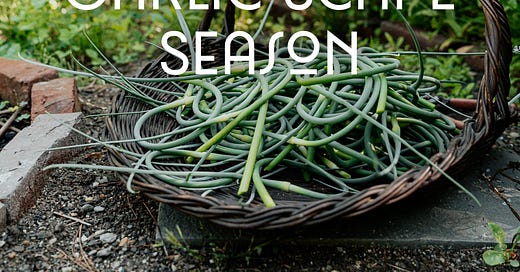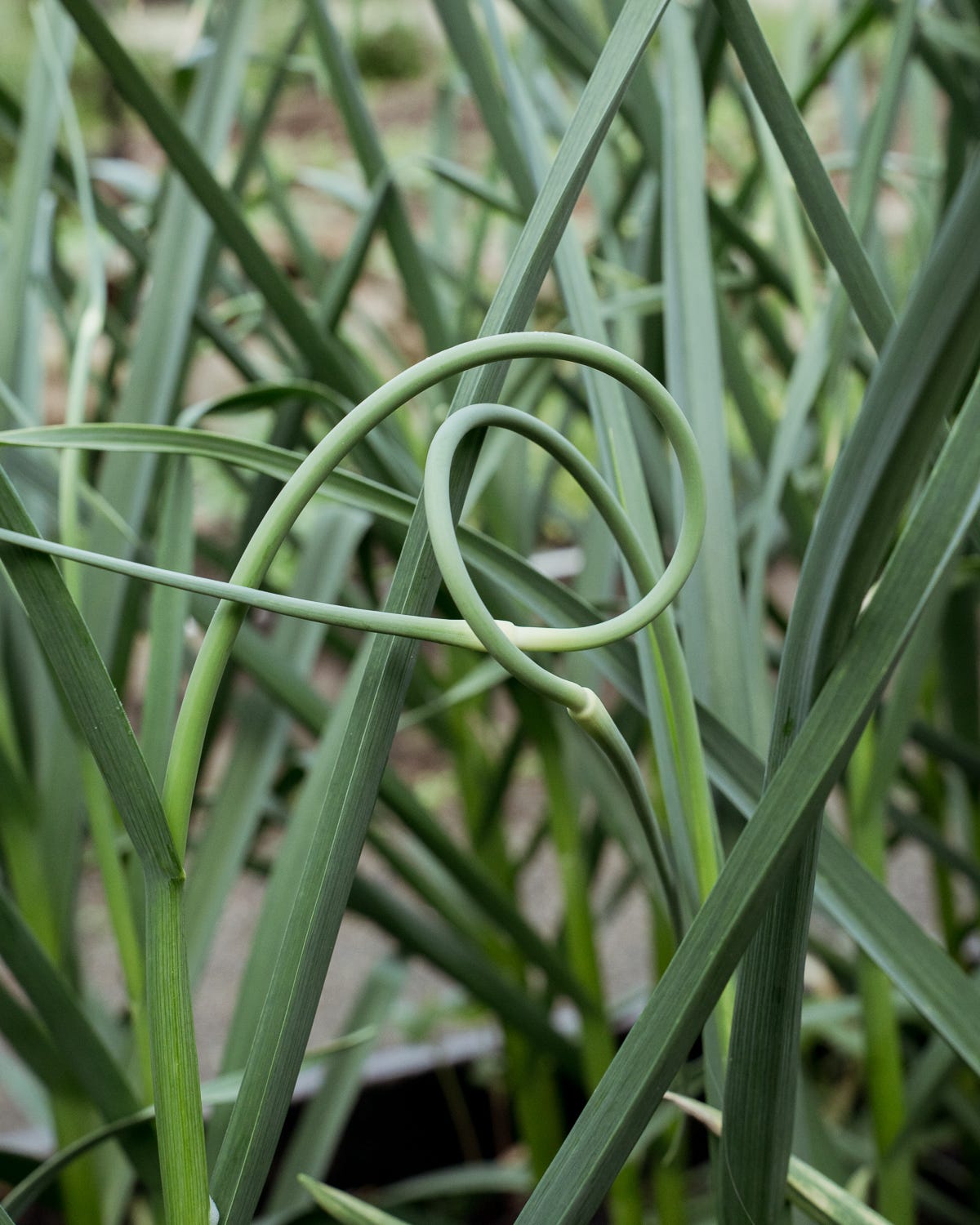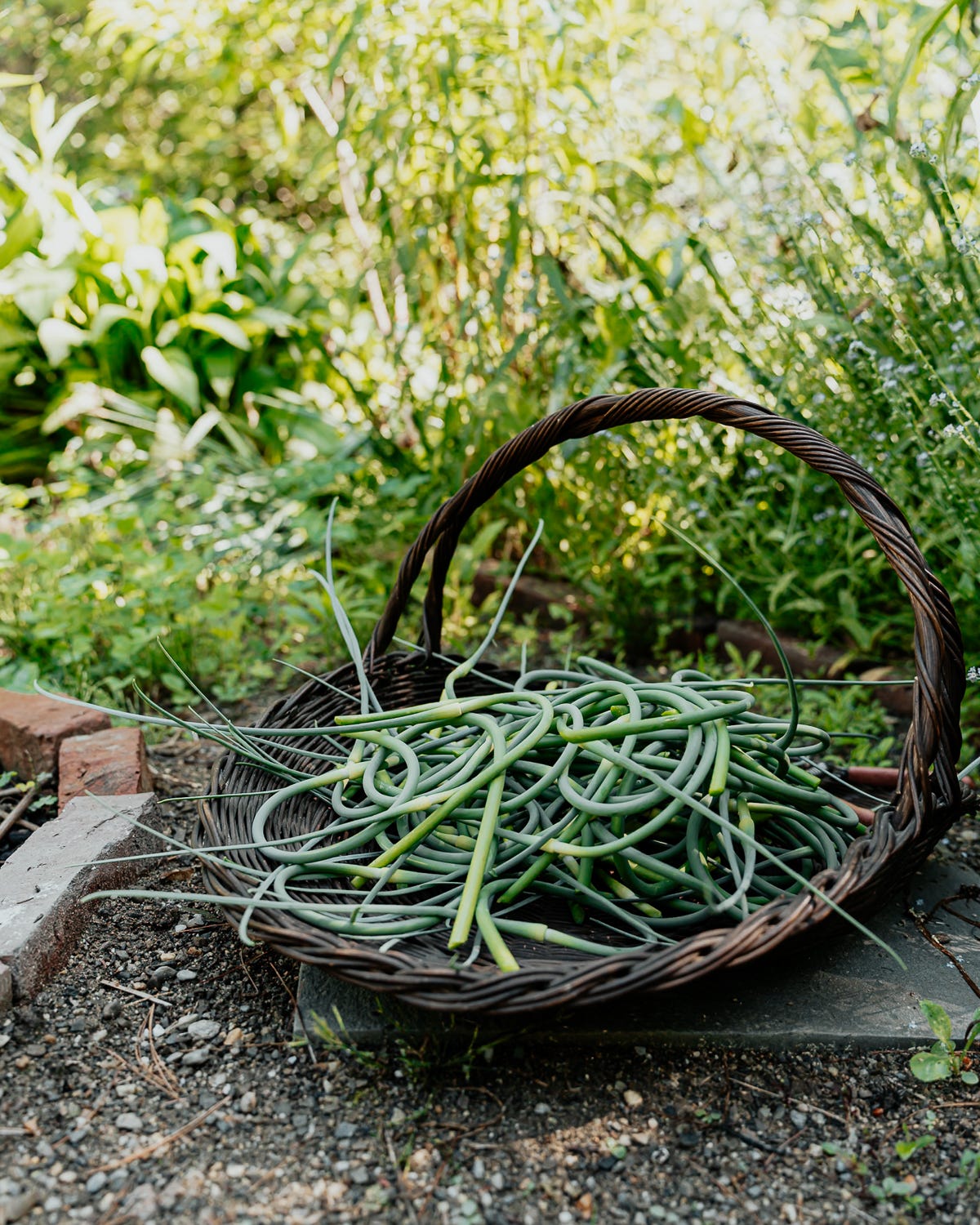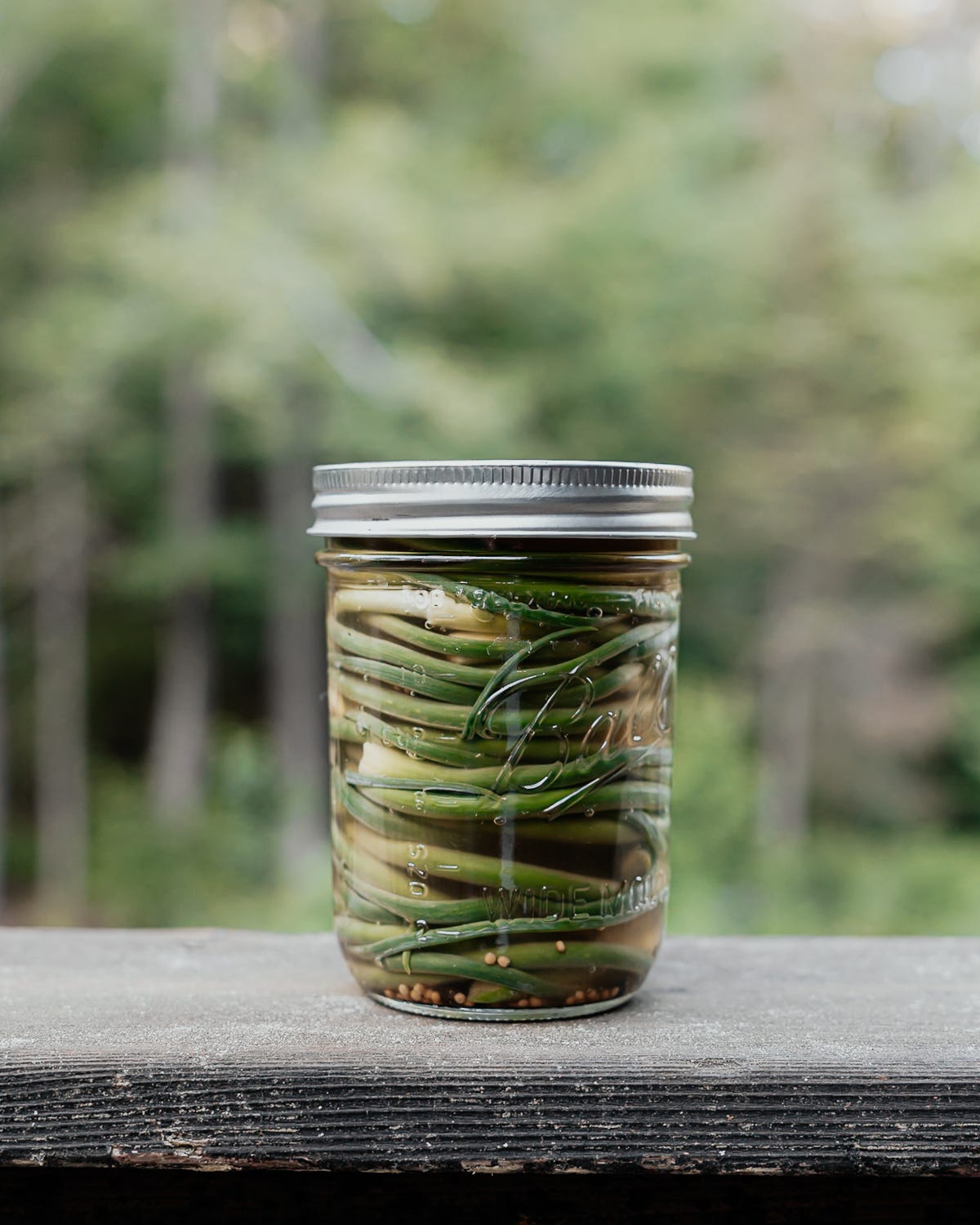It took me two years of utter failure to master growing garlic in Maine. But once I figured the timing of planting (Halloween weekend) and a feeding schedule (blood meal, mid-April and beginning of May), garlic is now one of my most dependable crops.
There are two main types of garlic: hardneck and softneck. Softneck types are what’s mostly grow commercially, and the ones you usually find in the grocery store. If you have a head of garlic that has multiple “circles” of cloves, with the nice sized cloves on the outside and tiny cloves on the inside, you have the softneck type.
Hardneck garlic is the variety that grows best in my region, and I plant two pounds every year. They are usually ready to harvest mid-July. But before that, around the summer solstice, I get a little something extra—garlic scapes.
Are you familiar with scapes? The hardneck variety wasn’t common in my region back in California, and so it wasn’t until I started growing garlic myself in Maine that I encountered such a thing.
Garlic scapes are the immature flower of the garlic plant, and is a slender stem that comes from the top of the plant. It twists and curls and then forms a pointed bud of a flower head.
If left alone, this would turn into a flower, but you want to make sure to pick them before that. Otherwise, the plant puts all its ever into the flower instead of the head of garlic, and I’d rather have big heads of garlic than garlic flowers.
Once they curl, the scapes are ready to pick. If you leave them growing for too long, they get tough, and you risk them flowering. They are easy to pick, and I use my clippers to cut as close to the top leaf of the stalk as possible. Not all will be ready to pick at the same time, so there are often a few harvests.
Sometimes, I get impatient and pick then too early. If they hadn’t grown long enough to start to curl, the stem will continue to grow. I’ll go back and cut the stem again. It’s kind of strange, to see the decapitated flower stalk continuing to grow.
It’s best to use the scapes soon after harvesting. If they sit around in the fridge for too long, they can get woody and tough. I try to use them the same day I cut. You won’t find them at a commercial grocery, but if the hardneck variety of garlic grows in your region, you can find them at the farmers market or shops that carry local produce.
There is someone down the street from me with a honor-cooler on the driveway filled with scapes for sale—$4 a bunch. I don’t need to buy more, but I’ve been tempted to drive up to the house to say hello and see how much garlic they have planted!
You can use scapes in a variety of ways, but they aren’t a common ingredient found in cookbooks. It’s taken me some trial and error to figure out the best way to eat them. I thought I’d share how I use them in my house!
In place of garlic or chives
By this time of the year, last year’s harvest of garlic is used up, and the chives have faded in the heat. If a recipe calls for garlic or chives, I’ll chop up scapes and use them in their place.
In omelettes
Chopped up fine and mixed with other herbs like parsley and tarragon, I like adding them to omelettes.
Pickled
Around here, scape pickles are a common sight on charcuterie and pickle boards at farm-to-table restaurants or farm pop-up dinners. I like to make a jar for the fridge and pull a few out to have with cheese and a glass of wine for when I’m feeling fancy.
I make a hot pickle brine of water, apple cider vinegar, sugar, peppercorns and mustard seeds and pour into a mason jar. While they look amazing coiled into a jar, I found that the flower part of the scape is too tough to eat in this style, so I now only use the straight part of the stem and use the flower for something that gets cooked.
In a green sauce
Every summer, I make lots of “green sauce” to put into the freezer. I blend up whatever herbs are plentiful, put into 4 oz. jelly jars and freeze, and then pull out in the depths of winter and serve with roasted meats or potatoes or stir into soups.
The exact ingredients various year to year, based on what I have a lot of. Sometimes I use scallions, but scapes also work just great. Sometimes I roast them first, sometimes they get chopped up raw.
The exact recipe is very loose: herb + scapes + acid + olive oil + salt. Last year, I did parsley, scapes, and lemon juice, which was gre. This year, I did cilantro, scapes, and lime, which will be great with beans or on tacos.
Roasted Scape Butter
This is another thing that I prep for the freezer, for what I call my “flavor drawer”. I roast the scapes until lightly charred, then chop them up fine in a food processor. I then mix this in with softened butter and a dash of salt. I put about teaspoon sized blobs on parchment and once frozen, will wrap each individual portion in parchment and store in a mason jar. I’ll use them throughout winter to add flavor and fat for roasted things.
In Stir Fry
Instead of acting as a seasoning, they can also be enjoyed as the main veggie. I like to use them in a pork stir-fry that I eat with noodles or rice. I chop into about 1” pieces, and to lightly soften, will saute for a few minutes in a splash of wine. Then, I’ll add ground pork, ginger, and soy sauce and cook up until the pork is done.
Scape season signals that in about a month, the garlic will be ready to harvest. I’ll be sure to share about that, then!
If you’re familiar with scapes, I’d love to know how you like to use them!










Love scapes! I add them to omelets and fritata, soup, stir fry, garlic cheese muffins and biscuits, pizza, chili, and in place of green onions on potatoes and rice.
I make Garlic Scape Pesto. The pesto can be spread on sour dough bread to make delicious toasts and the pesto makes a wonderful addition to pasta!